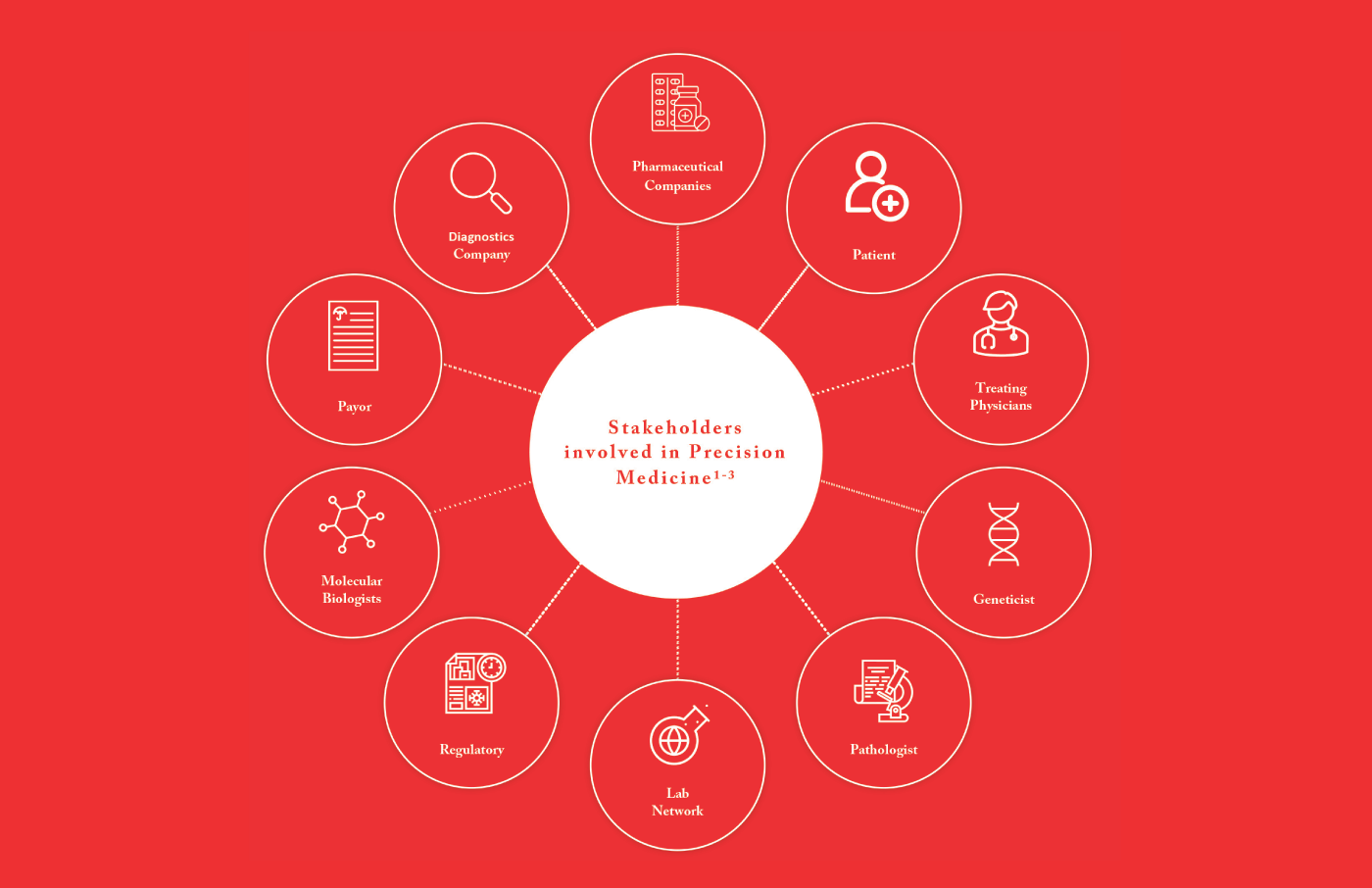Janssen Pharmaceutica NV, a Johnson & Johnson company, has funded the development and publication of this article, including a consultancy fee for Professor Aleš Ryška. The views expressed in the article are those of the authors and publisher, and do not necessarily reflect the views of Janssen Pharmaceutica NV and/or Johnson & Johnson. CP-465155 August 2024
Today’s cancer diagnosis is based not only on tumor origin and stage but also on its molecular profile (1). Comprehensive biomarker testing, as part of the initial diagnostic process, can help ensure optimal systemic treatment selection and identify those patients who are most likely to respond to specific targeted therapies – but only if we work collaboratively (2). Multidisciplinary information flows within regional oncology networks hold the key to early diagnosis and optimal treatment selection for patients.

The current landscape of biomarker testing
In adult solid tumors, the greatest advancements in biomarker testing have been made in lung cancer. The rapid progress was driven largely by the discovery of novel treatments, such as kinase inhibitors, that have now been on the market for more than 15 years (3, 4). This led to a huge investment in biomarker research in order to match the right patients to each new therapy.
Another factor was the great number of genomic alterations in lung cancer – each of them presenting in a very small subset of the patient population. Whilst EGFR and KRAS G12C mutations are relatively common, other mutations constitute a very small population, which, combined, appear in around one third of all NSCLC tumors (5–9). It was important to look for those “needles in a haystack” via biomarker research in order to effectively treat as many patients as possible.
The good news is that progress in molecular profiling is also now being made in colorectal, ovarian, endometrial, urothelial, and gastric cancers, as well as in melanoma – a significant proportion of the landscape of solid oncology (1). However, investing in biomarker testing makes sense only if a corresponding treatment is available. In some countries, where the availability of new targeted treatments is quite limited, it follows that molecular profiling is also limited (10, 11).
Yet, even where targeted therapies are available, there is an urgent need for improved utilization of biomarker testing, particularly in bladder and prostate cancers, to help patients receive tailored therapy options earlier in their treatment journey.
Barriers to optimal use of biomarker testing
In genitourinary cancers, biomarker testing is far less established than in lung cancer, therefore education and awareness among pathologists and oncologists is less advanced (12). However, labs that are already fully equipped for biomarker testing in lung cancer will be well placed to introduce similar testing for those other cancer types.
Of course, for any lab introducing a new testing capability, the first major hurdle is funding. Where this is not available internally, alternative means such as sponsorship or financing through research projects are sought (11). Sadly, such sources are neither reliable nor sustainable (11).
Another barrier is the size of the lab and the volume of work. In-house next-generation sequencing isn’t economically viable for every single small (low-throughput) pathology department (13). For this reason, in certain cases it makes sense to establish more centralized testing centers – or centers of excellence – for molecular testing.
In the Czech Republic, among our seventy or so pathology departments, around fourteen of them provide molecular testing. When lung cancer is diagnosed in one of the small labs, the specimen will be sent reflexively to one of the centralized testing labs. Immediately, this reduces patient leakage from the precision pathway due to lack of referrals. Results are returned to the source efficiently and, if positive for targetable mutation, we advise the local oncologist to send the patient to the Comprehensive Cancer Center to access the appropriate treatment.
However, for such centralized services to succeed, well-designed logistics are essential to ensure fast turnaround times. Smooth-running programs require careful organization and, ideally, involvement of the national pathology society, healthcare payers, and patient organizations.
The connected approach
The official opinion of the European Society of Pathology is that the genomic testing of cancer for somatic molecular alterations should be performed by pathologists (14). This is because pathologists have full oversight of the whole testing process – from the pre-analytic and analytic phases, through interpretation of the data, to reporting. The society also advocates for pathologists participating in (or even leading) multidisciplinary teams to ensure patients are referred to the right specialists earlier in their treatment pathway, have the right tests conducted, and have access to the latest targeted treatments.
Molecular tumor boards are also crucial for correct interpretation of the data from genetic sequencing. Led by pathologists, our molecular tumor board at Charles University Medical Faculty connects oncologists from our own Comprehensive Cancer Center with those from local hospitals in the region. We discuss their patients and advise on which cases to refer to our center for targeted treatment. This prevents the leakage of patients with actionable mutations from appropriate and timely treatment pathways.
Education is key
In establishing our cancer networks in the Czech Republic, we took time to educate the local pathologists on accessing comprehensive care for their patients. We set out a clear process for ordering testing from the central testing labs, and found the system was adopted very quickly as a result.
In close collaboration with our national oncology society, we have also established a program of education for oncologists on treatment advances and the benefits of precision oncology, to maximize the uptake. For us, it was essential to establish this network of collaboration with regional oncology.
Picking up on the importance of digital learning, the European Society of Pathology offers several virtual preceptorships, which are online educational programs for specific cancers (15). Every society member has access to this fantastic, accredited platform at their fingertips.
The evidence base
We live in the world of evidence-based medicine. Diagnosis of rare cancers such as angiosarcoma, where the evidence base is lacking, can be very challenging (16). Additionally, monitoring the quality of biomarker testing in individual laboratories may be difficult. I strongly believe in the value of national oncology registries to fill this void.
For example, in the Czech Republic we have had a breast cancer registry for more than 10 years that monitored biomarker testing – primarily HER2, but other biomarkers, such as Ki67, ER and PR were also recorded (17). This allowed us to compare diagnostic performance across the fourteen central testing laboratories and provided objective feedback. Similarly, our non-small cell lung cancer (NSCLC) registry collects data on molecular testing methods, specific mutations detected, and turnaround times in all newly diagnosed cases of NSCLC (18). Again, this provides crucial data: from turnaround time and performance of individual labs, to comparison of test method sensitivities and technology purchasing decisions.

The ideal world
The optimal model for cancer diagnostics, in my opinion, incorporates a well-established network of laboratories, including smaller local departments providing the specimens, centralized regional testing centers, multidisciplinary teams collaborating on interpretation of results, and molecular tumor boards advising on cases across the network.
In an ideal world, this all works together efficiently to deliver the right diagnosis to each patient in clinically sufficient time, with no delays. In my dream, molecular test results are reliable and clinically significant, with all costs covered by healthcare insurance or systemic funding.
With this vision in mind, my call to action to the medical community is twofold: continued education on biomarker testing and its importance, and greater involvement of the pathologist in clinical decision making. Only if the clinicians have all the information on grading, staging, and molecular testing of an individual patient, are they in a position to make a qualified decision about that patient’s cancer treatment. In this respect, the pathologist is now the keystone of the oncology decision making process.

References
- C Wenzel et al., “Routine molecular pathology diagnostics in precision oncology,” Dtsch Arztebl Int, 118 (2021). PMID: 33536117.
- EA Perez, “Biomarkers and precision medicine in oncology practice and clinical trials,” Advancing the Science of Cancer in Latinos, Chapter 11. Springer:2020.
- TS Mok et al., “Gefitinib or carboplatin-paclitaxel in pulmonary adenocarcinoma.” N Engl J Med, 361, 10 (2009). PMID: 19692680.
- D Kazandjian et al., “FDA approval summary: crizotinib for the treatment of metastatic non-small cell lung cancer with anaplastic lymphoma kinase rearrangements,” Oncologist, 19, 10 (2014) PMID: 25170012.
- SV Sharma et al., “Epidermal growth factor receptor mutations in lung cancer,” Nat Rev Cancer, 7, 3 (2007). PMID: 17318210.
- W Pao, N Girard, “New driver mutations in non-small-cell lung cancer,” Lancet Oncol, 12, 2 (2011). PMID: 21277552.
- Cancer Genome Atlas Research Network, “Comprehensive genomic characterization of squamous cell lung cancers,” Nature, 489, 7417 (2012). PMID: 22960745.
- FR Hirsch et al., “New and emerging targeted treatments in advanced non-small-cell lung cancer,” Lancet, 388, 10048 (2016). PMID: 27598681.
- S Devarakonda et al., “Genomic alterations in lung adenocarcinoma,” Lancet Oncol, 16, 7 (2015). PMID: 26149886.
- JP Radich et al., “Precision medicine in low- and middle-income countries,” Annu Rev Pathol, 17 (2022). PMID: 35073168.
- EFPIA, “Unlocking the potential of precision medicine in Europe” (2021). Available at: https://www.efpia.eu/media/589727/unlocking-the-potential-of-precision-medicine-in-europe.pdf
- PA Videira et al., “Editorial: Biomarkers in genitourinary cancers, volume 1,” Front Oncol, 12, 965294 (2022). PMID: 35880166.
- Y Akkari et al., “Implementation of cancer next-generation sequencing testing in a community hospital,” Cold Spring Harb Mol Case Stud, 5, 3 (2019). PMID: 31160354.
- X Matias-Guiu et al., “The leading role of pathology in assessing the somatic molecular alterations of cancer: position paper of the European Society of Pathology,” Virchows Arch, 476, 4 (2020). PMID: 32124002.
- European Society of Pathology. “Virtual Education Series” (2024). Available at: https://www.esp-pathology.org/education/virtual-education-series.html
- CE Holm et al., “A population-based long-term follow-up of soft tissue angiosarcomas: characteristics, treatment outcomes, and prognostic factors,” Cancers (Basel), 16, 10 (2024). PMID: 38791913.
- Registry.cz, “MAGISTER” (2024). Available at: https://www.registry.cz/index-en.php?pg=registries--all&prid=52
- Registry.cz. “KELLY” (2024). Available at: https://www.registry.cz/index-en.php?pg=registries&prid=5

